Citroen JUMPY 2016 2.G Owner's Manual
Manufacturer: CITROEN, Model Year: 2016, Model line: JUMPY, Model: Citroen JUMPY 2016 2.GPages: 595, PDF Size: 12.47 MB
Page 111 of 595

109
Jumpy _en_Chap03_ergonomie-et-confort_ed01-2016
Work tableIf fitted to your vehicle, the backrest of the
bench centre seat tips for ward to form a
pivoting work table, creating a mobile office
(when stationary).
F
P
ull the grip at the top of the backrest. Never use the table while driving.
An object on the table could turn in to
a projectile and cause injuries under
heavy braking or in the event of an
impact.
Centre seat storage
F Pull the strap for ward to tip the seat cushion.
Ensure that the size, shape and volume
of loads carried are compatible with
the driving and safety regulations and
do not compromise the driver's field of
vision.
Lash all loads appropriately, to prevent
or limit their movement and avoid the
risk of injury.
Install the non-slip net (supplied with
the vehicle) every time the seat is raised
and the partition flap removed.
Do not use the net for other purposes.
Check the condition of the non-slip
net regularly. Replace it when it shows
signs of wear or tears, going to a
CITROËN to obtain a replacement
non-slip net to the specification and
quality defined by CITROËN for your
vehicle.
Refit the flap in the partition when no
longer carrying a long load.
3
Ease of use and comfort
Page 112 of 595

110
Jumpy _en_Chap03_ergonomie-et-confort_ed01-2016
Fixed one-piece bench seat
F To raise a head restraint, pull it up until it engages in its notches.
F
T
o remove the head restraint, press the
lug
A and pull the head restraint upward.
F
T
o put it back in place, engage the head
restraint rods in the apertures keeping
them in line with the seat backrest.
F
T
o lower it, press on the lug A and on the
head restraint at the same time. F
P
lace the head restraints in the low position.
The different items of equipment and
adjustments described hereafter vary
according to the version and the configuration
of your vehicle.
The bench seat includes a one-piece backrest
which may be fixed or folding (table position).
Angled head restraints Folding the seat backrest to
the table position
For more information on the Seat belts ,
refer to the corresponding section. F
F
rom the front, raise the handle to release
the seat backrest.
F
F
rom the rear, lower the handle to release
the seat backrest.
F F old the backrest onto the seat cushion.
F
T
o return the backrest to its normal
position, raise the handle and pull the
backrest up.
Ease of use and comfort
Page 113 of 595
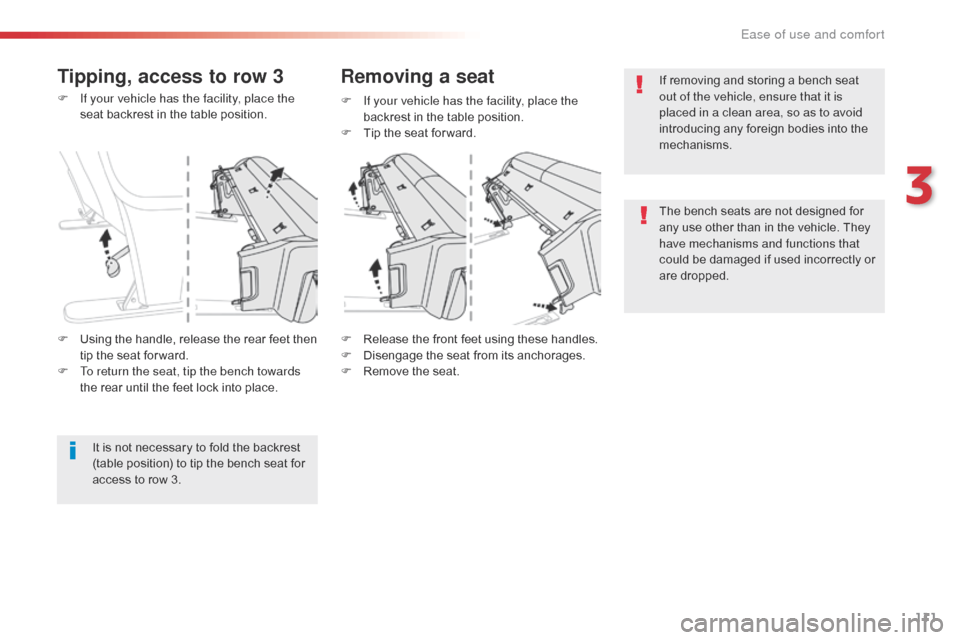
111
Jumpy _en_Chap03_ergonomie-et-confort_ed01-2016
F If your vehicle has the facility, place the seat backrest in the table position.
F
R
elease the front feet using these handles.
F
D
isengage the seat from its anchorages.
F
R
emove the seat.
F
I f your vehicle has the facility, place the
backrest in the table position.
F
T
ip the seat for ward.
Tipping, access to row 3 Removing a seat
It is not necessary to fold the backrest
(table position) to tip the bench seat for
access to row 3.
F
U
sing the handle, release the rear feet then
tip the seat for ward.
F
T
o return the seat, tip the bench towards
the rear until the feet lock into place. If removing and storing a bench seat
out of the vehicle, ensure that it is
placed in a clean area, so as to avoid
introducing any foreign bodies into the
mechanisms.
The bench seats are not designed for
any use other than in the vehicle. They
have mechanisms and functions that
could be damaged if used incorrectly or
are dropped.
3
Ease of use and comfort
Page 114 of 595

112
Jumpy _en_Chap03_ergonomie-et-confort_ed01-2016
F If your vehicle has the facility, pull the control and raise the backrest (from the
rear, lower the lever).
Check that the seat has correctly
engaged in its anchorages on the floor
when returned to the seating position. Ensure that no object, or the feet of a
passenger seated at the rear, could
obstruct the anchorage points or prevent
the correct latching of the assembly.
F
C
heck that there is nothing obstructing the
anchorages or which would prevent the
correct engagement of the feet.
Refitting a seat
F Lock the front feet using the handles.
F T ip the seat toward the rear until the rear
feet lock into place.
Be aware of the feet of any passengers
while tipping the seat.
F
E
ngage the front feet in the anchorages in
the floor (as shown above).
Ease of use and comfort
Page 115 of 595
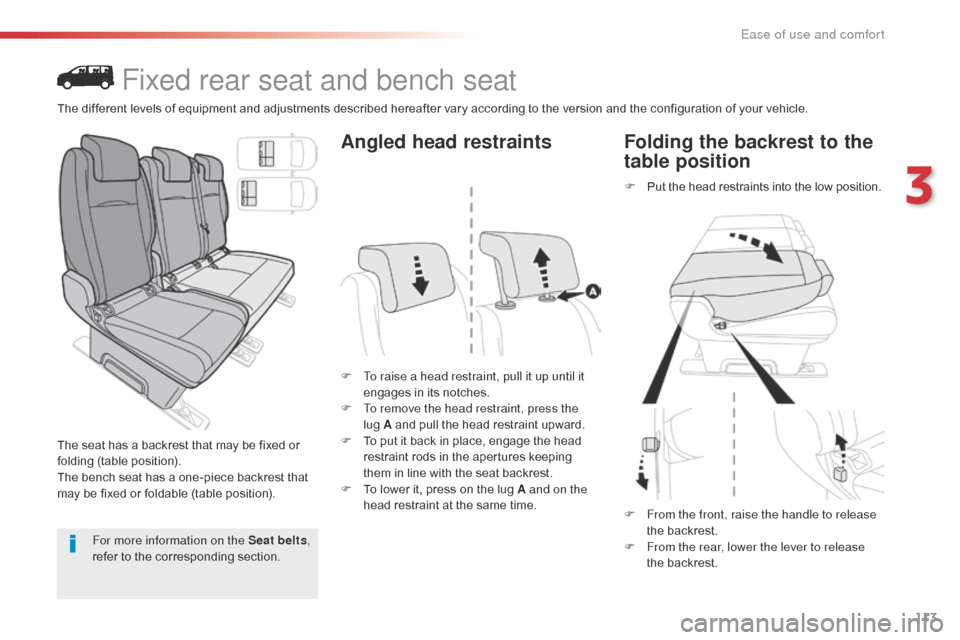
113
Jumpy _en_Chap03_ergonomie-et-confort_ed01-2016
Fixed rear seat and bench seat
The seat has a backrest that may be fixed or
folding (table position).
The bench seat has a one-piece backrest that
may be fixed or foldable (table position).F
T
o raise a head restraint, pull it up until it
engages in its notches.
F
T
o remove the head restraint, press the
lug A and pull the head restraint upward.
F T o put it back in place, engage the head
restraint rods in the apertures keeping
them in line with the seat backrest.
F
T
o lower it, press on the lug A and on the
head restraint at the same time.
Angled head restraints
F Put the head restraints into the low position.
Folding the backrest to the
table position
For more information on the Seat belts ,
refer to the corresponding section. F
F
rom the front, raise the handle to release
the backrest.
F F rom the rear, lower the lever to release
the backrest.
The different levels of equipment and adjustments described hereafter vary according to the version and the configuration of your vehicle.
3
Ease of use and comfort
Page 116 of 595

114
Jumpy _en_Chap03_ergonomie-et-confort_ed01-2016
F If your vehicle has the facility, place the backrest in the table position.
F
T
ip the seat for ward.
F
U
sing the handle, release the rear feet then
tip the seat for ward.
F
T
o return the seat to the normal position,
unfold the seat backwards until the rear
feet engage in their anchorages.
F
I
f your vehicle has the facility, place the
backrest in the table position.
Fully folding a seat, access to row 3
(example of an individual seat)
Removing a seat
(example of an individual seat)
It is not necessary to fold the backrest
(table position) to tip the bench seat for
access to row 3.
F
F
old the backrest onto the cushion.
F
T
o return the backrest to the normal
position, raise the lever and pull the
backrest up (from the rear, lower the lever). F
R
elease the front feet using the handles.
F
D
isengage the seat from its anchorages.
F
R
emove the seat by the sliding door in
row
2 or from the rear in row 3.
Ease of use and comfort
Page 117 of 595
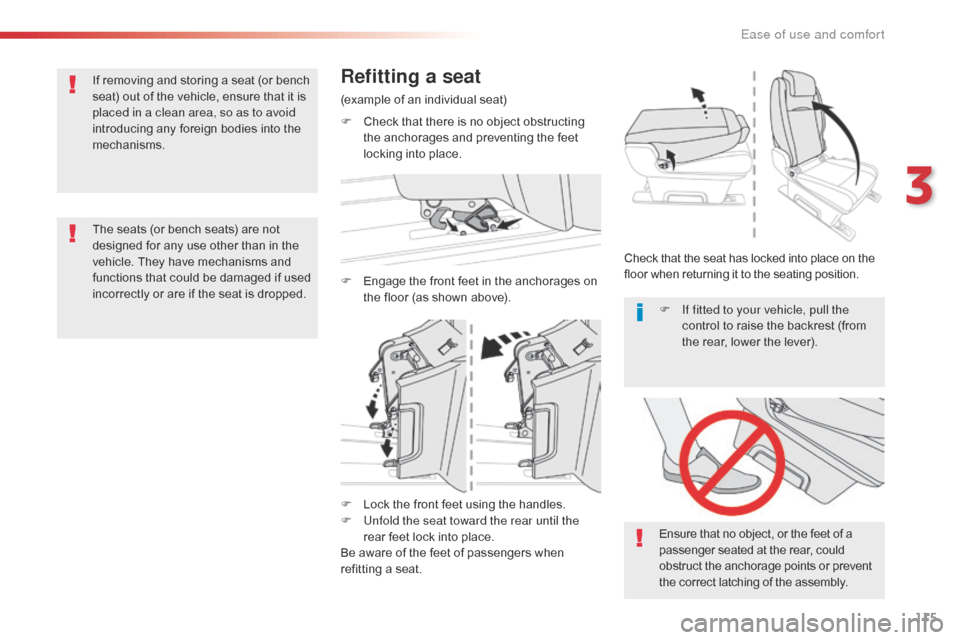
115
Jumpy _en_Chap03_ergonomie-et-confort_ed01-2016
F Lock the front feet using the handles.
F U nfold the seat toward the rear until the
rear feet lock into place.
Be aware of the feet of passengers when
refitting a seat. Ensure that no object, or the feet of a
passenger seated at the rear, could
obstruct the anchorage points or prevent
the correct latching of the assembly. F
I
f fitted to your vehicle, pull the
control to raise the backrest (from
the rear, lower the lever).
The seats (or bench seats) are not
designed for any use other than in the
vehicle. They have mechanisms and
functions that could be damaged if used
incorrectly or are if the seat is dropped. If removing and storing a seat (or bench
seat) out of the vehicle, ensure that it is
placed in a clean area, so as to avoid
introducing any foreign bodies into the
mechanisms.
Refitting a seat
(example of an individual seat)
F
C
heck that there is no object obstructing
the anchorages and preventing the feet
locking into place.
F
E
ngage the front feet in the anchorages on
the floor (as shown above). Check that the seat has locked into place on the
floor when returning it to the seating position.
3
Ease of use and comfort
Page 118 of 595
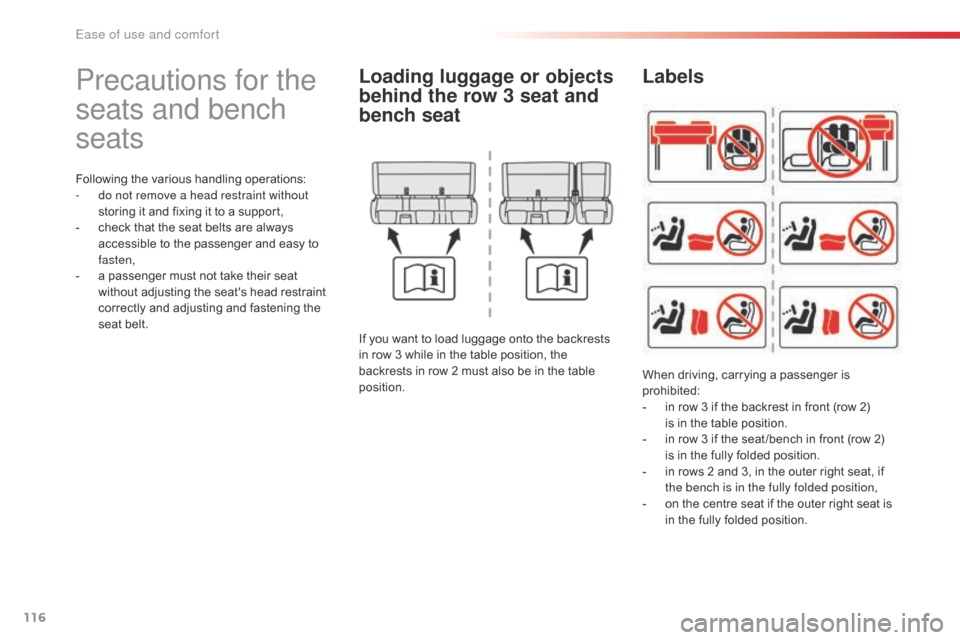
116
Jumpy _en_Chap03_ergonomie-et-confort_ed01-2016
Precautions for the
seats and bench
seats
Following the various handling operations:
- d o not remove a head restraint without
storing it and fixing it to a support,
-
c
heck that the seat belts are always
accessible to the passenger and easy to
fasten,
-
a p
assenger must not take their seat
without adjusting the seat's head restraint
correctly and adjusting and fastening the
seat belt.
Loading luggage or objects
behind the row 3 seat and
bench seat
If you want to load luggage onto the backrests
in row 3 while in the table position, the
backrests in row 2 must also be in the table
position.
Labels
When driving, carrying a passenger is
prohibited:
-
i
n row 3 if the backrest in front (row 2)
is in the table position.
-
i
n row 3 if the seat /bench in front (row 2)
is in the fully folded position.
-
i
n rows 2 and 3, in the outer right seat, if
the bench is in the fully folded position,
-
o
n the centre seat if the outer right seat is
in the fully folded position.
Ease of use and comfort
Page 119 of 595

117
Jumpy _en_Chap03_ergonomie-et-confort_ed01-2016
Fixed crew cab
This comprises a bench seat, seat belts, storage spaces (depending on equipment) and side
windows.
It is separated from the loading area by a high-strength partition offering comfort and safety.
Rear bench seatStorage boxes
If fitted to your vehicle, a storage box is
provided at the front, under the bench seat.
This ergonomic bench seats three people.
The two outer seats are equipped with ISOFIX
mountings.
Storage boxes below the
seats
For more information on the ISOFIX
mountings , refer to the corresponding
section. If fitted to your vehicle, they are located below
the centre and outer left seat.
For access to them from the cab, tip the seat
cushion in question for ward.
3
Ease of use and comfort
Page 120 of 595
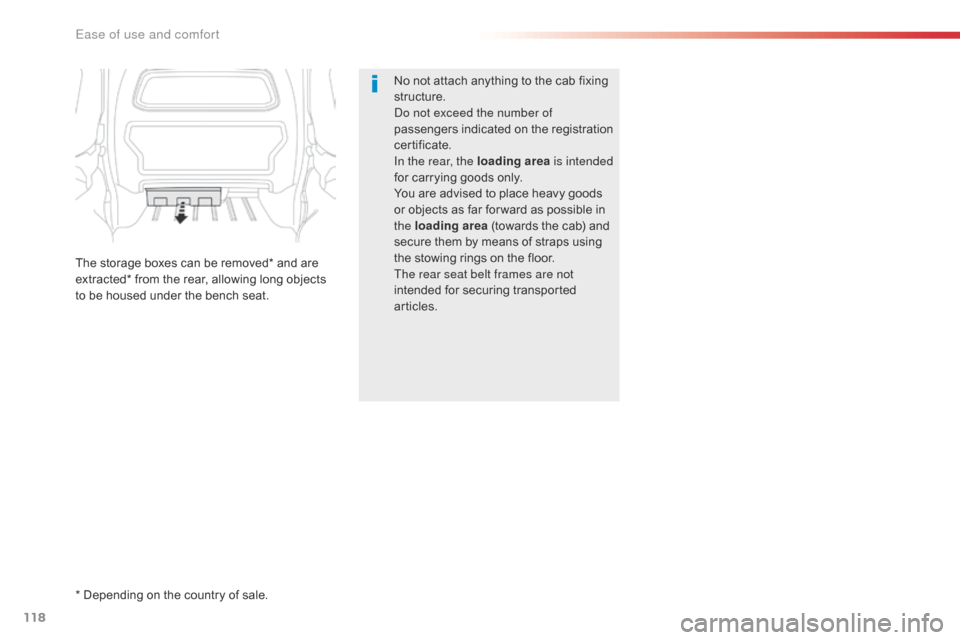
118
Jumpy _en_Chap03_ergonomie-et-confort_ed01-2016
No not attach anything to the cab fixing
structure.
Do not exceed the number of
passengers indicated on the registration
certificate.
In the rear, the loading area is intended
for carrying goods only.
You are advised to place heavy goods
or objects as far for ward as possible in
the loading area (towards the cab) and
secure them by means of straps using
the stowing rings on the floor.
The rear seat belt frames are not
intended for securing transported
articles.
The storage boxes can be removed* and are
extracted* from the rear, allowing long objects
to be housed under the bench seat.
* Depending on the country of sale.
Ease of use and comfort